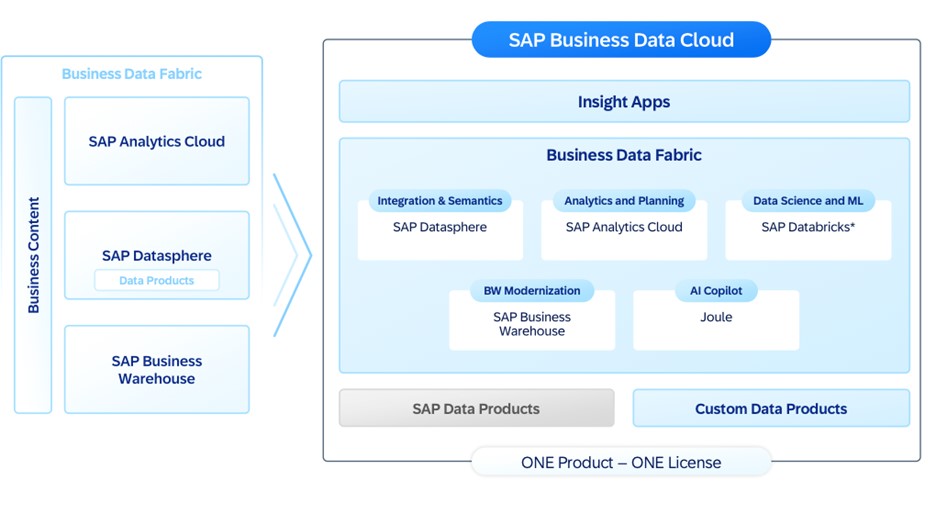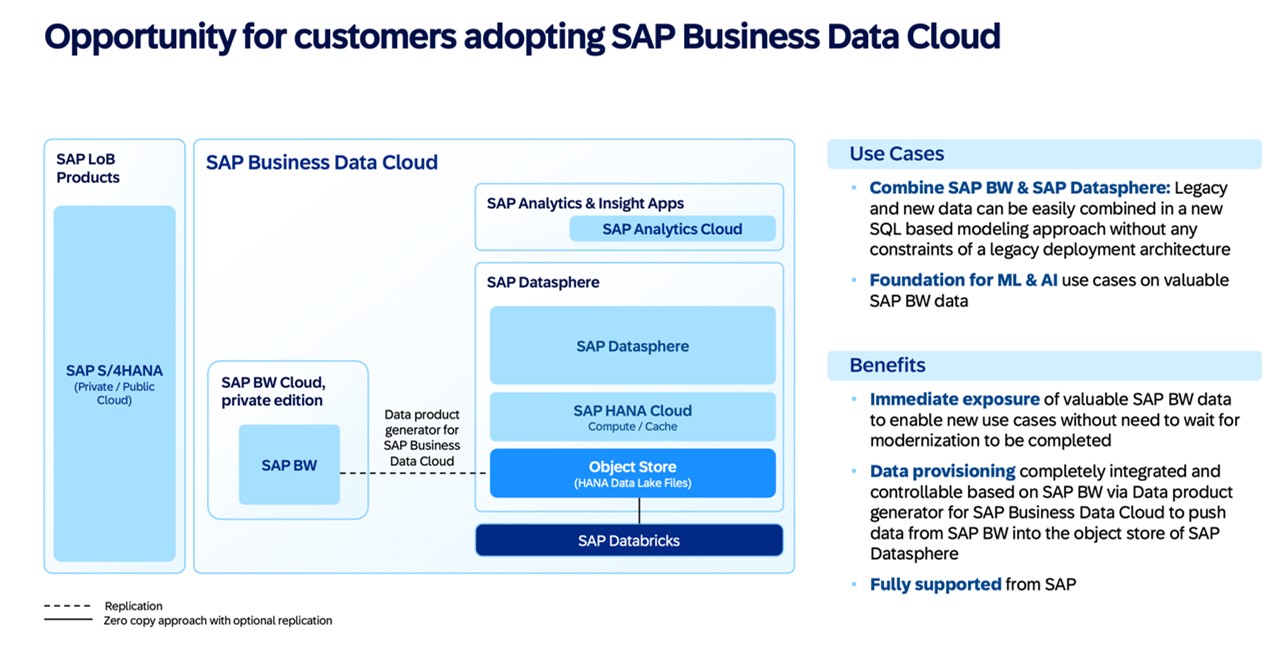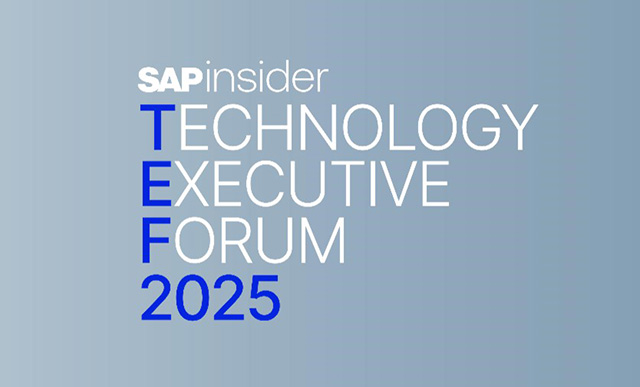Embracing SAP Business Warehouse Modernization with SAP Business Data Cloud
Meet the Authors
Key Takeaways
Organizations can leverage a flexible migration strategy with SAP Business Data Cloud to modernize their SAP BW systems without disrupting critical business operations, allowing for scalability and enhanced agility.
The integration of SAP Business Data Cloud with advanced analytics tools like SAP Datasphere and SAP Databricks enables enterprises to quickly gain actionable insights from their existing data assets, fostering data-driven decision-making and innovation.
Transitioning to a unified data management approach through SAP Business Data Cloud optimizes costs and simplifies governance by utilizing a zero-copy method, improving data consistency and resource allocation for better operational performance.
Many organizations using SAP Business Warehouse (BW) acknowledge the advantages of cloud modernization, including enhanced scalability, agility, and advanced analytics capabilities (In this context, SAP Business Warehouse refers to both SAP BW for SAP NetWeaver and SAP BW/4HANA.) Yet, they require a flexible migration approach that preserves existing investments and ensures uninterrupted critical operations. By adopting a balanced modernization strategy, enterprises can progressively integrate advanced analytics while retaining essential workflows and infrastructure, thus enabling continuous business functionality and data-driven innovation.
Challenges with Traditional SAP BW Systems
Legacy SAP BW solutions, although reliable, require data to be replicated and centralized in the SAP BW system, something which is less than optimal in a modern business environment where organizations want to limit replication where possible. Utilizing a data fabric, a combination of data architecture and dedicated software solutions that centralize, connect, manage, and govern data across systems and applications, provides for more streamlined data management. As organizations look for cost-efficient data management solutions that make data readily accessible, solutions using an approach that requires centralization may restrict businesses from fully capitalizing their extensive data assets, creating more data silos, and limiting the potential for growth and innovation.
Unifying Data with SAP Business Data Cloud
SAP Business Data Cloud addresses these modernization challenges by providing a unified platform designed to streamline data consolidation and analytics. Not only does it continue to provide a simplified integration of data from both SAP and non-SAP systems, it brings together the data that is currently in SAP BW systems with other corporate data and combines it with machine learning and AI foundation. This platform promotes agility through scalable cloud infrastructure, semantic onboarding, real-time data integration, and AI-powered insights through the SAP Analytics Cloud and SAP Datasphere, significantly enhancing an organization’s responsiveness and strategic decision-making capabilities.
Explore related questions

Strategic Pathways for SAP BW Modernization
Organizations seeking to modernize their SAP BW environment need to take different approaches depending on their SAP BW version.
Transitioning from SAP BW/4HANA: Organizations already running, or in the process of converting to, SAP BW/4HANA already understand the benefits it offers including a streamlined data warehouse approach that provides agile and flexible data modeling, SAP HANA-optimized processes, and updated interfaces. They can move directly to SAP BW/4HANA Cloud, private edition, which offers additional benefits such as update control, customization and tailored solutions, and data tiering optimization (DTO) which helps reduce costs by reducing the overall footprint in SAP HANA.
Transitioning from SAP BW on NetWeaver: Organizations running SAP BW 7.5 on NetWeaver now have the same innovation path as those running SAP BW/4HANA. Once they lift their existing SAP BW system into the private cloud, they can use their SAP BW data as a source for direct consumption and new use cases in SAP Datasphere or SAP Databricks has well as other approved third-party applications in the future. In the past these steps required a full or partial conversion to SAP BW/4HANA. Now, customers can stay on their existing SAP BW for NetWeaver deployment while leaving the opportunity for a future move to SAP BW/4HANA. Should they wish to make that move, it can be a simple change request executed by SAP Services or a SAP partner once they have lifted their SAP BW system to the private cloud.
Accelerating Data-Driven Innovation with SAP BW Modernization
SAP’s comprehensive BW modernization strategy significantly enhances an organization’s capability to strategically harness and innovate using its data. By transitioning to SAP Business Data Cloud, enterprises achieve the flexibility to modernize progressively while immediately capitalizing on robust analytical capabilities. The integration of advanced AI-driven analytics through SAP Datasphere and SAP Databricks enables businesses to quickly transform traditional data sets into actionable insights, accelerating strategic decision-making and fostering continuous innovation.
SAP Business Data Cloud (BDC) adoption equips organizations with cutting-edge, cost-effective cloud architectures that emphasize agility, scalability, and operational efficiency. This efficient approach ensures businesses can swiftly respond to evolving market demands without disruption.
Sign up for a free-of-charge SAP Customer Evolution kit for BW Modernization | SAP Customer Evolution Kit, which includes the free SAP Business Data Cloud assessment
Leveraging SAP Datasphere Capabilities and SAP Databricks
SAP Datasphere extends far beyond traditional data warehousing by embracing advanced capabilities such as semantic onboarding, analytics, data governance, and innovative lakehouse architecture. The platform decouples storage and compute, offering unprecedented flexibility and scalability. Enterprises can easily leverage these robust capabilities for comprehensive, real-time analytics. Enterprises can efficiently execute complex data transformations and analytics workflows using Spark’s scalable compute capabilities, reducing operational complexities traditionally associated with legacy ABAP code. A core strength of SAP Business Data Cloud is its seamless integration with SAP Databricks, allowing organizations to directly leverage sophisticated artificial intelligence, machine learning, and data science applications, fostering innovation and enhancing data utilization.

Advantages for Enterprises
Shifting an SAP Business Warehouse (BW) system into the private cloud offers organizations a strategic modernization path without immediately requiring a conversion to SAP BW/4HANA. SAP ensures a seamless, disruption-free transition, allowing enterprises to incrementally migrate their SAP BW environments to the private cloud. SAP’s approach preserves existing operational stability, enhances accessibility, and ensures optimized performance during and after migration.
Post-migration, enterprises quickly capitalize on their data assets through advanced SAP Business Data Cloud capabilities. By using the Data Product Generator, businesses efficiently provision and connect validated SAP BW data into SAP Datasphere , which can then be accessed by SAP Databricks, enabling immediate deployment of sophisticated analytics and AI/ML solutions with valuable semantics kept intact. This seamless integration supports real-time analytics, provides AI-driven insights, and fosters an innovative environment without extensive upfront transformations. Businesses benefit from a unified data environment, real-time analytical insights directly integrated into operational workflows, AI-driven analytics, and optimized cost management through zero-copy sharing, significantly enhancing agility and strategic decision-making. Some of the core benefits include:
- Immediate Data Insights: Rapid exposure of SAP BW data, facilitating immediate analytics and ML/AI use cases.
- Unified Governance and Modeling: Provides clarity, consistency, and enhanced data governance.
- Flexibility and Scalability: Offers seamless integration and interoperability through the software-as-a-service environment allowing organizations to selectively use capabilities depending on their needs and requirements.
Benefits of SAP BW in the Private Cloud
Organizations transitioning their SAP Business Warehouse to the SAP Business Data Cloud unlock significant strategic and operational benefits, positioning themselves effectively for future growth and innovation. One advantage is immediate value realization. Having either lifted their SAP BW for NetWeaver deployment to the private cloud or moved to SAP BW/4HANA Cloud, data can be directly connected to SAP Datasphere which allows it to be used for advanced analytics and artificial intelligence (AI) scenarios, eliminating the delay typically associated with full-scale modernization efforts.
This approach is enabled with the SAP Data Product Generator streamlines the transformation of SAP BW data into structured, accessible data products. This capability allows enterprises to quickly provision data products that integrate seamlessly with SAP Datasphere and SAP Databricks, enabling agile and rapid analytics. Consequently, businesses achieve enhanced responsiveness, swiftly translating data insights into actionable strategies.
Additionally, cost efficiency is significantly improved through the adoption of zero-copy data management enabled by object-store technology and Delta Share integration, which enables a lakehouse architecture. By eliminating redundant data copies and optimizing storage utilization, organizations substantially reduce their overall storage expenses, enhancing resource allocation and financial performance. The streamlined architecture offered by SAP BDC lowers operational costs in addition to simplifying data governance and improving overall data management efficiency. In addition, it provides BW modernization through lifting existing BW deployments into the cloud which allows data from these systems to be utilized throughout SAP BDC.
What this means for SAPinsiders
Adopt a Flexible Migration Strategy: Organizations using traditional SAP Business Warehouse (SAP BW) face the challenge of balancing modernization with the need to maintain critical business operations. SAP Business Data Cloud provides a flexible and phased approach to cloud migration. Companies can continue leveraging their current SAP BW deployments while benefiting from the cloud’s scalability, security, and improved performance. Both SAP BW for NetWeaver and SAP BW/4HANA can be lifted into the cloud if a timeline past 2030 is required, plus customers can still convert BW to BW4 to get the longer EOM and some product advantages. By adopting a flexible migration strategy, enterprises avoid disruptive big-bang changes, maintain continuity in critical workflows, and progressively build a cloud-centric, agile data infrastructure aligned with their business priorities.
Unlock Immediate Value with Advanced Analytics: SAP Business Data Cloud enables businesses to swiftly realize the value of their existing data without lengthy or complex modernization efforts. Enterprises can quickly convert validated, existing SAP BW data into structured and easily accessible data products. These data products integrate seamlessly into analytics and AI platforms such as SAP Datasphere and Databricks, drastically accelerating the deployment of advanced analytical and machine learning scenarios. Additionally, organizations can leverage immediate, actionable insights from their existing datasets. This capability significantly reduces the time-to-insight, empowering decision-makers to respond swiftly to market dynamics, identify opportunities, and optimize operational strategies using real-time data-driven intelligence.
Optimize Costs and Data Governance with Unified Data Management: Migrating SAP BW environments to SAP Business Data Cloud enables enterprises to optimize costs and simplify data governance. Utilizing a zero-copy approach eliminates redundant data copies, significantly reducing storage expenses and establishing a consistent, authoritative data source. Additionally, SAP Datasphere’s unified semantic layer promotes standardized definitions and robust governance, improving data consistency, compliance, and trust across SAP and non-SAP sources. Coupled with a scalable and flexible infrastructure, businesses can dynamically allocate resources to match evolving analytics demands, enhancing performance, cost-efficiency, and overall agility.








